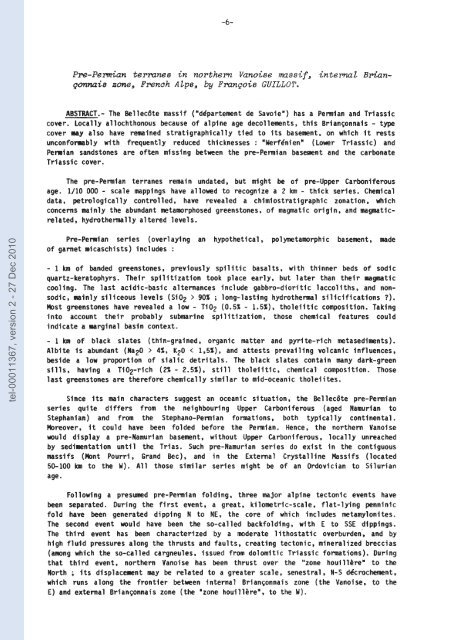Géologie de l'Antépermien de Vanoise septentrionale (zone ...
Géologie de l'Antépermien de Vanoise septentrionale (zone ...
Géologie de l'Antépermien de Vanoise septentrionale (zone ...
You also want an ePaper? Increase the reach of your titles
YUMPU automatically turns print PDFs into web optimized ePapers that Google loves.
tel-00011367, version 2 - 27 Dec 2010<br />
Pm-Pemiun termnes in northern <strong>Vanoise</strong> massif, internat Brian-<br />
çonnais <strong>zone</strong>, French Atps, by François GUILLOT.<br />
ABSTRACT.- The BellecGte massif ("département <strong>de</strong> SavoieM) has a Pennlan and Trlasslc<br />
cover. Locally allochthonous because of alpine age <strong>de</strong>collenients, thls Briançonnais - type<br />
cover may also have reinalned stratigraphically tled to lts basement, on whlch lt rests<br />
unconfomabl y wi th frequentl y reduced thicknesses : *krfënienm (Lower Trlasslc) and<br />
Pemlan sandstones are often mlsslng between the pre-Pennian basement and the carbonate<br />
Trlassic cover.<br />
The pre-Pennlan terranes remai n undated , but might be of pre-Upper Carboniferous<br />
age. 1/10 000 - scale mapplngs have allowed to recognlze a 2 km - thlck serles. Chernical<br />
data, petrological ly control led, have revealed a chimlostratigraphic zonation, whlch<br />
concerns mainly the abundant metainorphosed greenstones, of magmatlc orlgln, and magmatic-<br />
related, hydrothermally al tered levels.<br />
Pre-Pennlan series (overlaying an hypothetical, polymetamorphic basement, ma<strong>de</strong><br />
of gamet micaschists) inclu<strong>de</strong>s :<br />
- 1 km of ban<strong>de</strong>d greenstones, prevlously spi1 ltic basal ts, wi th thinner beds of sodic<br />
quartz-keratophyrs. Their spi1 1 tizatlon took place earl y, but later than thelr mgmatic<br />
cool lng. The last acldic-basic alternances incl u<strong>de</strong> gabbro-diori tic laccol lths, and non-<br />
sodic, minly siliceous levels (Si02 > 902 ; long-lasting hydrothermal slliclflcations ?).<br />
Most greenstones have revealed a low - TlO2 (0.5% - 1.52). tholelitic composition. Taking<br />
into account their probably subnarlne spilitlzation, those chemlcal features could<br />
indlcate a marginal basin context.<br />
- 1 km of black slates (thln-grained, organic matter and pyrite-rlch metasediments).<br />
Alblte is abundant (Na20 > 4%. K20 < 1.52). and attests prevalllng volcanlc Influences,<br />
besl<strong>de</strong> a low proportion of slallc <strong>de</strong>tritals. The black slates contain many dark-green<br />
sllls, having a TIOZ-rlch (2% - 2.5%). still tholelltlc, chemlcal composltlon. Those<br />
last greenstones are therefore chemically simllar to mld-oceanic tholelites.<br />
Slnce lts main characters suggest an oceanic si tuatlon, the Bel lec6te pre-Pennian<br />
serles qulte dlffers from the neighbouring Upper Carbonlferous (aged Namurlan to<br />
Stephanlan) and from the Stephano-Pennian formations, both typlcally continental.<br />
Moreover, lt could have been fol<strong>de</strong>d before the Pennlan. Hence, the northern <strong>Vanoise</strong><br />
would dlsplay a pre-Namurian basement, without Upper Carbonlferous, locally unreached<br />
by sedlmentatlon untll the Trias. Such pre-Namurian series do exlst ln the contlguous<br />
massifs (Mont Pourri, Grand Bec), and in the External Crystalllne Massifs (located<br />
50-100 km to the W). Al1 those similar series might be of an Ordovlcian to Silurian<br />
age .<br />
Fol lowing a presusned pre-Permian folding , three major alpine tectonlc events have<br />
been separated. During the flrst event, a great, kilometrlc-scale, flat-lying penninic<br />
fold have been generated dipping N to NE, the core of which lnclu<strong>de</strong>s metamylonltes.<br />
The second event would have been the so-called backfoldlng, wlth E to SSE dipplngs.<br />
The third event has been characterized by a nro<strong>de</strong>rate lithostatlc overbur<strong>de</strong>n, and by<br />
high fluid pressures along the thrusts and faults, creating tectonic, mlneralized breccias<br />
(amng whlch the so-cal led cargneules, issued from dolml tic Trîassic formations). During<br />
that third event, northern <strong>Vanoise</strong> has been thrust over the "<strong>zone</strong> houill&ren to the<br />
North ; i ts displacement niay be related to a greater scale, senestral, N-S décrochement,<br />
whlch runs along the frontier between interna1 Briançonnais <strong>zone</strong> (the Vanolse, to the<br />
E) and external Briançonnais <strong>zone</strong> (the *<strong>zone</strong> hou1 1 lère", to the W) .

















